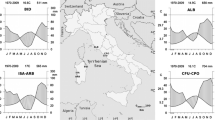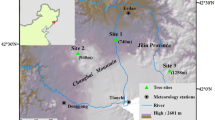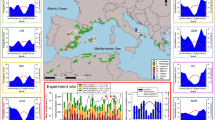Abstract
• Context
The correlation between tree ring width and density and short-term climate fluctuations may be a useful tool for predicting response of wood formation process to long-term climate change.
• Aims
This study examined these correlations for different radiata pine genotypes and aimed at detecting potential genotype by climate interactions.
• Methods
Four data sets comprising ring width and density of half- and full-sib radiata pine families were used. Correlations with climate variables were examined, after the extraction of the effect of cambial age.
• Results
Cambial age explained the highest proportion of the ring to ring variation in all variables. Calendar year and year by family interaction explained a smaller but significant proportion of the variation. Rainfall had a positive correlation with ring width and, depending on test site, either a negative or positive correlation with ring density. Correlations between temperature during growing season and ring density were generally negative.
• Conclusion
Climate variables that influence ring width and wood density can be identified from ring profiles, after removing the cambial age effect. Families can be selected that consistently show desirable response to climate features expected to become prevalent as a result of climate change.



Similar content being viewed by others
References
Apiolaza LA (2009) Modeling wood quality using random regression splines. Australasian Forest Genetics Conference. 20–22 April, Perth, Western Australia, Australia. http://apiolaza.net/publications.html Accessed 1 June 2012
Apiolaza LA, Garrick DJ (2001) Analysis of longitudinal data from progeny tests: some multivariate approaches. For Sci 47:129–140
Battaglia M, Bruce J, Brack C, Baker T (2009) Climate change and Australia’s plantation estate: analysis of vulnerability and preliminary investigation of adaptation options. Forest & Wood Products Australia Ltd. Melbourne
Booth TH, Kirschbaum MUF, Battaglia M, Stokes C, Howden M (2010) Adapting agriculture to climate change: preparing Australian agriculture, forestry and fisheries for the future. CSIRO, Melbourne, pp 137–152
Butler D, Cullis BR, Gilmour AR, Gogel BJ (2009) ASReml-R reference manual. Release 3.00. Department of Primary Industries and Fisheries, Queensland
Chen PY, Welsh C, Hamann A (2010) Geographic variation in growth response of Douglas-fir to interannual climate variability and projected climate change. Glob Chang Biol 16:3374–3385
CSIRO (2001) Climate change projections for Australia. www.dar.csiro.au/publications/projections2001.pdf. Accessed 1 Sept 2010
Dalla-Salda G, Martinez-Meier A, Cochard H, Rozenberg P (2009) Variation of wood density and hydraulic properties of douglas-fir (Pseudotsuga menziesii (mirb.) franco) clones related to a heat and drought wave in France. For Ecol Manag 257:182–189
De Martonne E (1926) L’indice d’aridite. Comptes Rengues de l’Academie des Sciences, Paris
R Development Core Team (2012) R: a language and environment for statistical computing, R Foundation for Statistical Computing, Vienna, Austria
Downes GM, Drew DM (2008) Climate and growth influences on wood formation and utilisation. South For 70:155–167
Downes GM, Drew D, Battaglia M, Schulze D (2009) Measuring and modelling stem growth and wood formation: an overview. Dendrochronol 27:147–157
Evans R, Ilic J (2001) Rapid prediction of wood stiffness from microfibril angle and density. For Prod J 51:53–57
Fritts HC (1976) Tree rings and climate. Academic, New York
Fritts HC, Shashkin AS, Downes GM (1999) TreeRing 3: a simulation model of conifer ring growth and cell structure. In: Wimmer R, Vetter RE (eds) Tree ring analysis: biological, methodological and environmental aspects. CAB International, Wallingford, pp 3–32
Gapare WJ, Wu HX, Abarquez A (2006) Genetic control in the time of transition from juvenile wood to mature wood in Pinus radiata D. Don. Ann For Sci 63:871–878
Gapare WJ, Ivković M, Dillon SK, Chen F, Evans R, Wu HX (2012) Genetic parameters and provenance variation of Pinus radiata D. Don. ‘Eldridge collection’ in Australia 2: wood properties. Tree Genet Genomes 8:895–910
Guller B, Isik K, Cetinay S (2012) Variations in the radial growth and wood density components in relation to cambial age in 30-year-old Pinus brutia Ten. at two test sites. Trees 26:975–986
Harrell FE (2001) Regression modeling strategies with applications to linear models, logistic regression, and survival analysis. Springer, Heidelberg, Springer Series in Statistics
Inc RI (2001) WinDendro and WinCell user manuals. Regent Instruments Inc., Québec
Ivković M, Rozenberg P (2004) Description and modelling of within-ring wood density in clones of three coniferous species. Ann For Sci 61:759–769
Ivković M, Gapare WJ, Abarquez A, Ilic J, Powell MB, Wu HX (2009) Prediction of wood stiffness, strength, and shrinkage in juvenile wood of radiata pine. Wood Sci Tech 43:237–257
Li L, Wu HX (2005) Efficiency of early selection for rotation-aged growth and wood density traits in Pinus radiata. Can J For Res 35:2019–2029
Littell RC, Milliken GA, Stroup WW, Wolfinger R (1996) SAS system for mixed models. SAS Institute Inc, Cary
Martinez-Meier A et al (2008) Genetic control of the tree-ring response of Douglas-fir (Pseudotsuga menziesii (Mirb.) Franco) to the 2003 drought and heat-wave in France. Ann For Sci 65:102
Martinez-Meier A, Sanchez L, Dalla-Salda G, Gallo L, Pastorino M, Rozenberg P (2009) Ring density record of phenotypic plasticity and adaptation to drought in Douglas-fir. For Ecol Manag 258:860–867
McLane SC, LeMay VM, Aitken SN (2011) Modeling lodgepole pine radial growth relative to climate and genetics using universal growth-trend response functions. Ecol Appl 21:776–788
Peltola H, Gort J, Pulkkinen P, Gerendiain AZ, Karppinen J, Ikonen VP (2009) Differences in growth and wood density traits in Scots pine (Pinus sylvestris L.) genetic entries grown at different spacing and sites. Silva Fenn 43:339–354
Rozenberg P, Franc A, Bastien C (2001) Improving models of wood density by including genetic effects: a case study in Douglas-fir. Ann For Sci 58:385–394
Rozenberg P, Schüte G, Ivkovich M, Bastien C, Bastien JC (2004) Clonal variation of indirect cambium reaction to within-growing season temperature changes in Douglas-fir. For (Oxford) 77:257–268
Verbyla AP, Cullis BR, Kenward MG, Welham SJ (1999) The analysis of designed experiments and longitudinal data by using smoothing splines (with discussion). App Stat 48:269–311
Acknowledgments
Thanks to Li Li and Aljoy Abarquez who processed samples and produced data sets used in this study. Thanks also to Leopoldo Sanchez, Jean-Charles Bastien, Luc Paques and Frederic Millier of INRA, Orléans, France for their time spent in discussions with the senior author. Data sets used in this study originate from two projects funded by Forest and Wood Products Australia. The senior author’s visit to INRA, France and this research were funded by the 2010 Fellowship from J.W. Gottstein Memorial Trust.
Author information
Authors and Affiliations
Corresponding author
Additional information
Handling Editor: Gilbert Aussenac
Contribution of co-authors Dr. Gapare contributed data and ideas, and reviewed the final manuscript.
Dr Wu organised the sampling of field trials, contributed data and reviewed the final manuscript.
Mr Espinoza contributed ideas and commented on methodology and earlier drafts of the manuscript.
Dr Rozenberg contributed to data analyses (R functions) and ideas that initiated this work.
Rights and permissions
About this article
Cite this article
Ivković, M., Gapare, W., Wu, H. et al. Influence of cambial age and climate on ring width and wood density in Pinus radiata families. Annals of Forest Science 70, 525–534 (2013). https://doi.org/10.1007/s13595-013-0290-z
Received:
Accepted:
Published:
Issue Date:
DOI: https://doi.org/10.1007/s13595-013-0290-z




